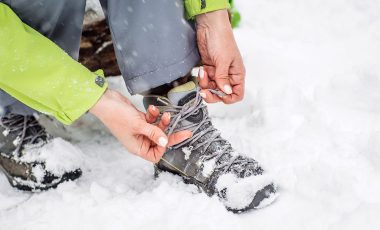Winter is coming (for Game of Thrones fans and avoiders alike…)! Yes, dear Cool of the Wilders, the nights are getting shorter and the mercury on the thermometers is dropping digits like autumn leaves. While the bears, badgers and good-weather hikers are all preparing for their annual hibernation, however, there are those of us awaiting the coming of the snow and chilly weather like kids before Christmas!
One problem…feet! We all have them. We all want to keep them. And we all want to keep them as cosy, comfortable and equipped for a challenge as possible when we head out on our winter wanders. But how? And with what?
Wearing warm socks is a start. But proper hiking adventures during the winter call for nothing but the best winter hiking boots.
- FAQs when choosing the best winter hiking boots
- What to look for in winter hiking boots
- Non-Technical winter hiking boots
- Technical winter hiking boots
Read on for our guide on how to choose a winter hiking boot followed by our selection of the best winter hiking boots of 2024!
Disclaimer: We use affiliate links and may receive a small commission on purchases.
| Product | Type of boot | Best for | Cost |
|---|---|---|---|
| Merrell Thermo Chill Mid Waterproof Boots | Non-technical | Hiking in light snow | $ |
| The North Face Chilkat V 400 Waterproof | Non-technical | Walking in deep snow | $$ |
| Salomon OUTblast TS CSWP Winter Hiking Boots | Non-technical | Lightweight, everyday winter wear | $ |
| Hanwag Abisko GTX Winter hiking boots | Non-technical | Very cold conditions, deep snow | $$$$ |
| KEEN Revel IV High Polar Hiking Boots | Non-technical | Hiking in deep snow | $$ |
| Danner Arctic 600 Side-Zip Hiking Boots | Non-technical | Winter hiking | $$$ |
| Vasque Men's Snowburban II | Non-technical | Walking in deep snow | $$ |
| Scarpa SL Active Hiking Boot | Non-technical | A bit of everything! | $$$$ |
| La Sportiva Karakorum | Non-technical | A bit of everything! | $$$$ |
| Columbia Mens Bugaboot Plus III Omni-Heat | Non-technical | Hiking in snow | $ |
| Oboz Bridger 8" Insulated BDry | Non-technical | Hiking in deep snow | $$ |
| La Sportiva Nepal EVO GTX | Technical | Mountaineering | $$$$$$ |
| Scarpa Mount Blanc Pro GTX | Technical | Mountaineering | $$$$$ |
| Scarpa Manta Pro GTX | Technical | Mountaineering | $$$$$ |
FAQs when choosing the best winter hiking boots
If you don’t want to buy winter specific hiking boots, then yes, some regular hiking boots will be just fine to wear on short hikes in the snow. Look for waterproof boots with high ankles and solid, grippy soles. The Asolo Greenwood Hiking Boots are an excellent 3-season boot that will also perform well in moderate winter conditions.
That said, if you intend spending longer periods of time in the snow, you will need a winter hiking boot that is insulated. An inexpensive but warm option is the Merrell Moab Polar Waterproof Winter Boot.
If you are looking for a highly technical winter hiking boot that will keep your feet toastie and warm in the most extreme conditions and hiking scenarios then you should consider the La Sportiva Nepal EVO GTX Boot.
If you are looking for something better suited to less everyday hiking and winter wear then the Vasque Snowburban II Insulated Boots and the KEEN Summit County III Winter Boot are amongst the warmest winter hiking boots on our list.
What to look for in winter hiking boots
Type and use
Technical
Technical boots are those designed to cater to the demands of more extreme winter adventures. While they are most suitable for mountaineering and hiking on steeper ground, there’s no reason you couldn’t use these boots for less extreme activities like winter forest walks or other lower level adventures other than the stiffer sole (which can cause sore feet on very flat, hard surfaces) and the price…! All of the technical boots in our selection below boast crampon compatibility, aggressive tread patterns on the soles for grip and an articulated, stiff toe for kicking steps in snow or for more delicate moves on rock.
Non-technical
These boots are designed for gentler activities but maximum warmth. They don’t pack the same performance-wise as technical boots but often have an extra and very generous allowance of insulation, have greater flexibility, and are generally much lighter. Ideal for gentler hikes, forest walks or anything else on less challenging terrain.
Insulation
If you’re going to be trudging through icy or snow-covered ground for hours on end, some form of added insulation is vital. Insulation types vary, with the most common and effective using synthetic materials which breathe and dry more easily than wool or fleece-type materials. Different boots also offer different weight or volumes of insulation, usually measuring between 100g and 500g. If your toes tend to get a bit chilly, the higher the better.
Crampon compatibility
All of the technical boots in our review offer crampon compatibility, but for many this will be overkill. If you’re unlikely to be on steep and/or technical terrain, a non-technical boot will most probably do the job and in any case can be used with non-automatic, strap-on crampons if you do happen to hit any tricky and sharply-angled slopes. For those likely to be walking on icy, steep ground or hard snow, a boot with fully automatic or semi-automatic crampon compatibility is preferable.
Comfort
As with any hiking boot, the comfort levels provided by your winter boots is a key consideration. With many winter boots, the extremely stiff sole can become nigh on crippling after a while if your feet are not used to them and your hike is on any kind of paved or flat surface without snow cover. The easy solution to decision making in this respect centers on whether or not you anticipate heading above the snow line and onto steeper ground or not. If so, a stiffer technical boot becomes an option. If not, the more flexible (and cheaper!) non-technical boots in our selection will most probably do the job!
The best winter hiking boots for 2024
Got all that? Great! Now, let’s get down to our summary of the best winter hiking boots that your feet need to stay toastie this winter!
Non-Technical winter hiking boots

Merrell Thermo Chill Mid Waterproof Boots
If you’re looking for a comfortable pair of boots to see you through hikes in late autumn, early spring, or mild winters, then the Merrell Thermo Chill Mid Waterproof Boots are one of our favourites. They’re made from sustainably sourced leather and fitted with an ergonomic EVA midsole, a removable contoured insole, and moulded arch support.
At 2 lbs 4 oz a pair, they’re also one of the lighter winter hiking boots on our list. However, this lightweight and comfortable boot does compromise on warmth a little. The boots feature just 200g of low-bulk insulation. They perform best in shallow snow or mildly cold conditions but don’t provide enough insulation or waterproofing for extreme cold or hiking in deep snow.
Pros
- Fairly lightweight (2 lbs 4 oz)
- Comfortable and flexible fit
- Great traction
- Affordable price
Cons
- Not as warm as other winter boots
Find the latest price at:
REI
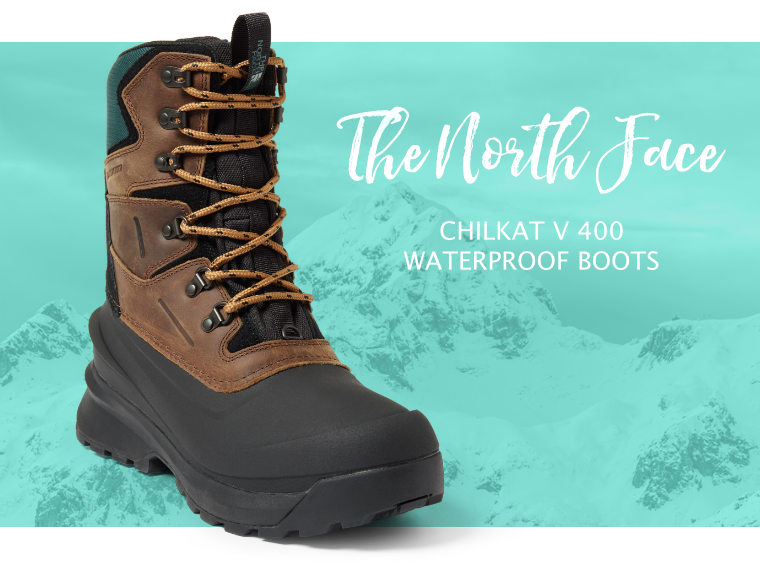
The North Face Chilkat V 400 Waterproof Hiking Boots
The North Face Chilkat V 400 Waterproof hiking boots are perfect for your winter hiking apparel. Their fully waterproof design and 400g heatseeker eco insulation are ideal for cold weather when you’re on the move. These boots work well for daily dog walks, winter hikes, and snowshoeing. Although they’re warm in those conditions, your feet may catch a chill if you are stationary for an extended period. Depending on your body and level of activity, your toes will likely get cold as there seems to be less insulation in the toebox compared to elsewhere on the boot.The tall upper design of the boot helps prevent snow from entering the boot, keeping your feet warm and dry all day long. Made from full-grain leather and suede, the upper offers good durability, so long as you take good care of it. Additionally, the large lugs of the sole and surface control rubber help give you the traction you need to have sure footing on ice, snow, slush, or mud.
Pros
- Compatible with snow shoes and gaiters
- Easy on and off
- High upper for better protection
- Secure, comfortable fit
Cons
- Not much insulation in the toes
Find the latest price at:
The North Face | REI | Alpine Trek

Salomon OUTblast TS CSWP Winter Hiking Boots
A lightweight winter hiking boot design, the Salomon OUTblast TS CSWP winter hiking boots are stylish and functional. Ideal for winter hiking and snowshoeing, you’ll also enjoy wearing these while running errands around town because, unlike other comparable winter boots, they are far less clunky. Although they’re functional enough to be worn daily in winter, they are primarily designed for outdoor activities. With 200g of 3M Thinsulate insulation, it is worth noting that these boots are not as highly insulated as other winter boots. Their design is best suited for cool winter days or a high level of movement and exertion. Regardless, a unique feature is the Molded OrthoLite sock liners. These help to regulate the temperature within the boot a bit better, especially while hiking, keeping your feet warm as you hike.
Pros
- Lightweight
- Stylish enough for daily winter wear
- Durable construction
- Aggressive traction
Cons
- Not as warm as other winter hiking boots
- Lacking high ankles, so not great for deep snow
Find the latest price at:
Salomon | REI
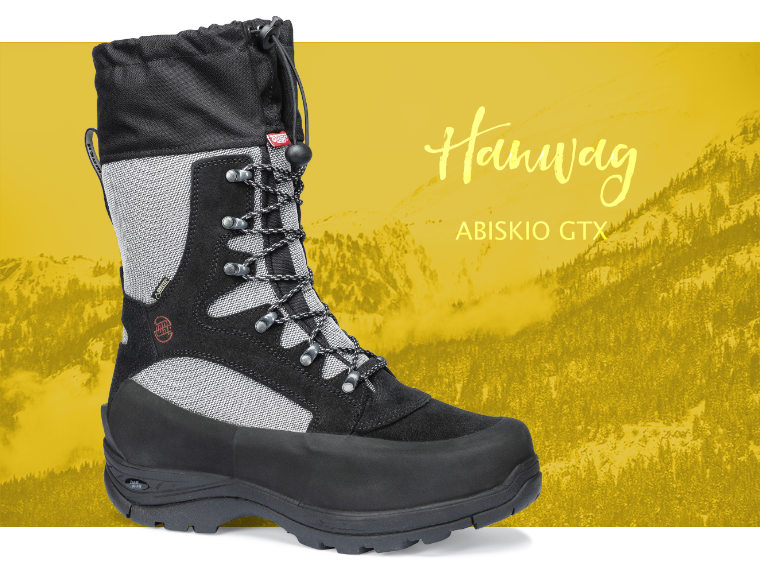
Hanwag ABISKO GTX Winter Boots
A far cry from the traditional winter boot, the Hanwag ABISKO GTX boots are designed for sub-zero expeditions. You’ll have minimal issues keeping your feet warm and protected as you navigate through frigid, icy conditions in these boots. The G-LOFT FIT insulation is made from down rated for temperatures as low as -45°C/-49°F. Along with the top-notch insulation, they also feature an integrated gaiter to prevent snow from entering the top of the boot. And for added functionality, when you’re lounging at basecamp, at a cabin, or in a snow hut, the removable thermal inner layer can double as a slipper or hut boot.
Pros
- Ideal for extreme winter weather
- Integrated gaiters
- Removeable liners
- Good traction even on ice
Cons
- Too bulky for casual winter use
Find the latest price at:
Hanwag
KEEN Revel IV High Polar Hiking Boots
Made from sustainably sourced leather and insulated with recycled PET fibres, the Keen Revel IV High Polar hiking boots are an environmentally-friendly choice of winter footwear. The boots are waterproof, breathable, and fitted with insulated insoles that trap heat. They boast a comfort temperature rating of -40ºF making them suitable for hiking in deep snow. 5mm multi-directional rubber lugs provide plenty of grip in the snow whilst a wide toe cap and high side supports help to protect your feet from rocks and trail debris. For comfortable all-day walking in the chilliest conditions, the Revel IV High Polar boots are also fitted with an EVA midsole and heel support.
Pros
- -40ºF temperature rating
- Made from durable materials
- Excellent traction
- Reasonable weight (2 lbs 6.8 oz)
- Available in men’s or woman’s versions
Cons
- A bit extreme for hikes in mild conditions or light snow
Find the latest price at:
Keen | Alpine Trek | REI
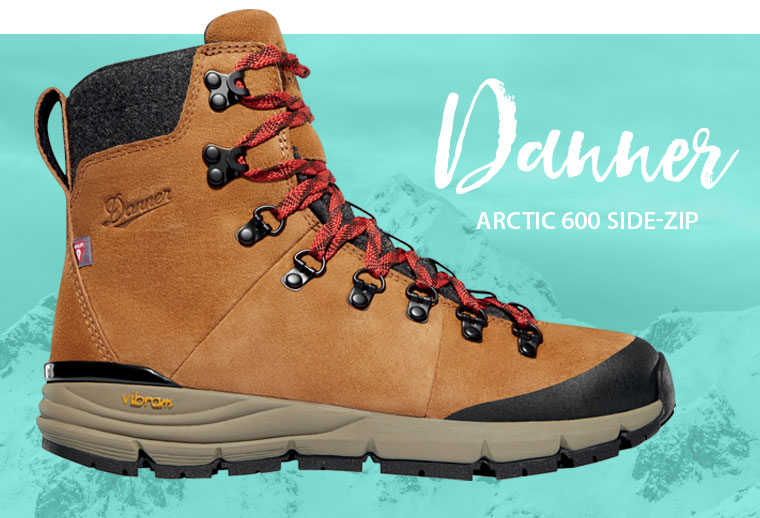
Danner Arctic 600 Side-Zip Hiking Boots
If you’re looking for a low-profile winter hiking boot with a women-specific fit, the Danner Arctic 600 Side-Zip Hiking Boots are our top choice. They’re best suited to easy to moderate hikes in light snow and chilly weather. But, they’re also stylish and comfortable enough for daily wear in wintertime. They’re made with high-quality suede uppers that are built to last. The boots contain 200g of Primaloft insulation and the outer is treated with a waterproof top layer. Plus, each pair comes with a 365-day warranty and the company, based in Oregon, offers a repairs service for when the boots start to wear out.
When it comes to comfort, these boots are designed to be comfortable straight out of the box. They feature a cushioned EVA midsole as well as a removable Ortholite footbed and reinforced heels. There’s even a side zip, making them super quick and easy to put on and take off when nipping out the house.
Pros
- Very comfortable
- Suitable for daily urban use as well as moderate trails
- Durable materials
- Vibram outer soles offer good traction
Cons
- Not the warmest winter boot
- Pricey compared to similar style boots
Find the latest price at:
REI Danner
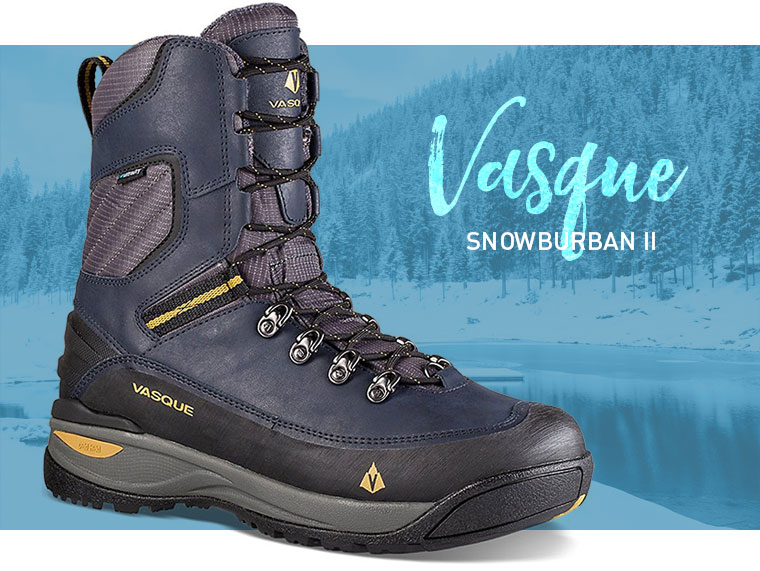
Vasque Snowburban II Insulated Boots
Boasting 400g of Thinsulate insulation, UltraDry lining, and ColdHold soles for super-grippyness, the Snowburban II is a toasty, functional, super-comfy boot ideal for hikes where things aren’t getting overly technical and/or steep. Although weighing in at a slightly ponderous 3lb 6oz per pair, the UltraDry lining and insulation (largely responsible for the increased poundage) not only keep the cold and damp out, but wick away any sweatiness while you’re on the move.
Pros
- Reasonably priced
- Very warm
- Very durable
- Great grip in powder snow!
Cons
- Flat and flexible sole makes them poor performers on steeper terrain
- Quite heavy (3lbs 6 oz)
Find the latest price on:
Amazon | REI
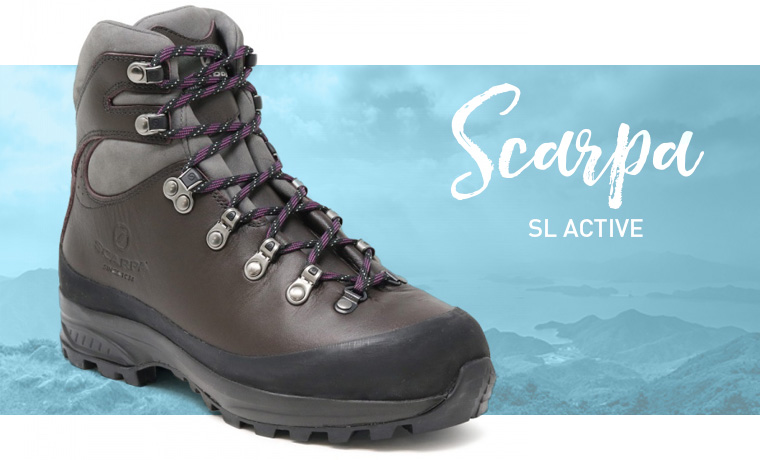
Scarpa SL Active Hiking Boot
Updated in 2020, these classic hiking boots have been roaming the hills and mountains of the UK and Europe since 1983. This latest version is as popular as ever with winter hikers taking on technical hikes and scrambles in cold and moderately snowy conditions. They owe their waterproofness and general robustness to the extra thick 2.8mm Sherpa leather uppers. Plus, they are incredibly comfortable, for a relatively stiff leather boot, thanks to the plush collar and ankle padding. Though they provide good warmth in conditions a little below 0ºC, they can’t compete with many of the insulated options on this list in this department. A great option for 3-4 season hikers in moderate conditions.
For more information read our full review of the Scarpa SL Active Hiking Boots.
Pros
- Very comfortable
- Good for technical hiking and scrambling
- Crampon compatible
- Women’s specific fit
Cons
- Not as warm as other options
Find the latest price on:
Backcountry | Scarpa

La Sportiva Karakorum
For the ideal ‘bridge’ boot between technical mountaineering boots and insulated winter hiking boots, look no further than the all-time classic and highly versatile La Sportiva Karakorum. These incredibly rugged boots are as much at home on a gentle forest walk as they are in the high mountains and offer B2 crampon compatibility to boot. They aren’t quite as well insulated as the top end (400g) insulated and non-technical boots in our review but offer a very robust alternative with much greater dexterity and all round performance.
Pros
- Flexible sole in a semi-technical boot (a con for some, granted…)
- Versatility – ideal for everything barring very technical mountaineering
- A great ‘bridge’ boot between more flexible trekking boots and stiffer mountaineering boots
Cons
- Take a while to break in
- Not as waterproof as competitors
- Heavy (4lbs/1820g per pair)
- Pricey
Find the latest price on:
La Sportiva | Alpine Trek | Backcountry

Columbia Mens Bugaboot Plus III Omni-Heat
The Bugaboot Plus III is an extremely comfortable, well-made boot that combines all of the best features available in its competitors at a lower cost. While it only has 200g of insulation, the Bugaboot III is warm enough when temperatures are around 30ºF (-1ºC), is very comfortable, and offers the feel of a standard hiking boot with increased grip and weather-proofing.
Pros
- Good value for money
- Versatile
- Rugged and durable
- Weighs 2lbs 14oz
Cons
- Only 200g of insulation
- Not as warm as competitors
Find the latest price on:
Amazon | REI

Oboz Bridger 8″ Insulated BDry Hiking Boot
Waterproof, very breathable and made with very tough, rugged leather, theBridger 8″ is a boot you can rely on when the weather takes a turn for the inclement. With an 8-inch collar height, comfy EVA midsoles, 200g of Thinsulate insulation and winterized rubber soles, the Bridger is both comfortable and built to deal with deep snow and rugged trails. It might not be as warm as competitors such as the Keen Summit County III or Vasque Snowburban, but it’s a fraction lighter, just as comfy and the slightly shorter (7” collar) version might just be the best women’s winter hiking boot for those of you not veering onto the super steep or technical stuff!
Pros
- Very breathable
- B-fit thermal wool-topped insoles very cosy
- Best for casual winter walking
Cons
- Only 200g of insulation
- Quite heavy (3lbs 1.2oz)
- Pricey
Find the latest price on:
Amazon | REI | Backcountry
Technical winter hiking boots
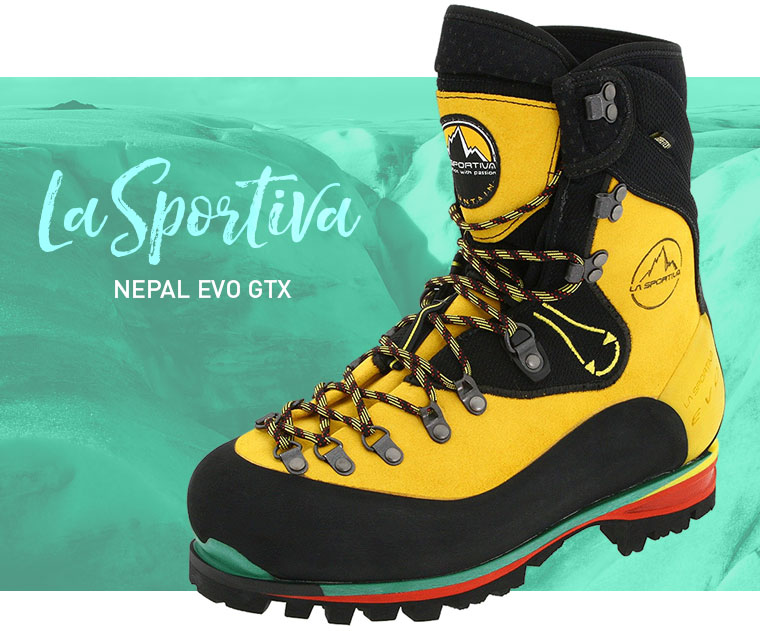
La Sportiva Nepal EVO GTX Boot
The all-time favourite of mountaineers just about everywhere, La Sportiva’s Nepal EVO is a beast of a boot that combines technicality with comfort. It’s not the cheapest boot out there, granted, but you get a lot of ‘damn, that’s good’ for your dollar! The construction and overall quality is second to none, and a pair of Nepal Evo’s will last you a lifetime if cared for properly. They boast a waterproof breathable Gore-Tex membrane, insulated lining, and a durable leather upper to keep your feet toasty wherever you might be headed (short of an 8000er!). A true contender for the title of both best men’s winter hiking boot and best women’s winter hiking boot!
Pros
- Very warm
- Detachable tongue prevents snow sneaking in at the top of your forefoot
- Extremely sturdy and durable (one pair could easily last you a lifetime)
- Unbeatable quality
- Step-in crampon compatibility
- Break in easily for such a tough boot
Cons
- Very pricey, but still offer great value for money
- Quite heavy (4lbs 9oz)
Find the latest price on:
Alpine Trek | REI | Backcountry | La Sportiva
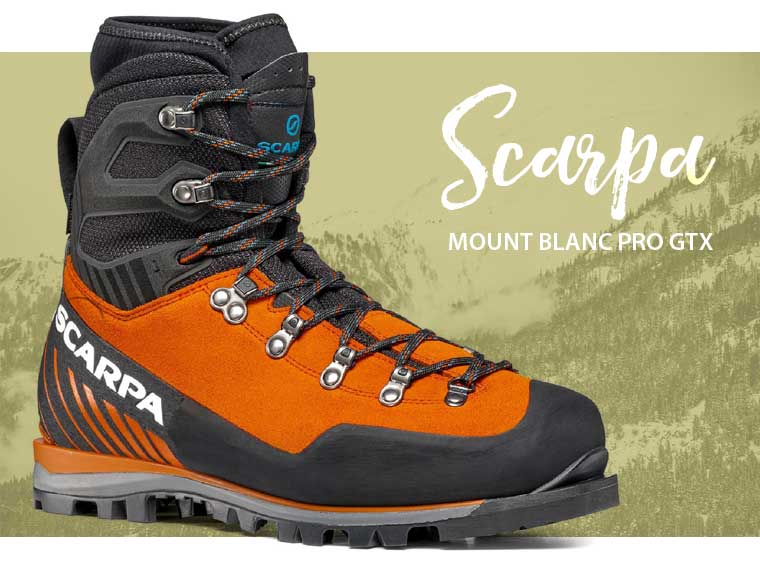
Scarpa Mont Blanc Pro GTX Mountaineering Boots
For a relatively lightweight technical, insulated boot that’s just as happy in the hills as it is on the snow-clad peaks, look no further than the Mount Blanc Pro GTX. It features a Gore-Tex Insulated lining for added warmth, comfort and weather-proofing, great breathability, step-in crampon compatibility and bomb-proof ruggedness. Again, this is a fairly pricey option but for the extra spend you get a very durable, well-made, versatile boot in return. Compared to the Nepal EVO, it’s a little lighter but just a fraction short in terms of insulation.
Pros
- Fairly lightweight (3.9 lbs / 1.78kg)
- Versatile
- Step-in crampon compatibility
- Rugged and durable
- Comfortable despite stiff sole
Cons
- A little less insulation than the Nepal EVO
Find the latest price on:
Alpine Trek | REI | Backcountry
From snow-bashing bruisers to toasty thwarters of foot-freeze, the above list offers a little bit of something for everyone. Whether you’re heading on high to scale a snowy peak or just trudging through the white stuff on lower-level hikes, we’re sure there’s something in there that will keep your feet comfy and cosy until Spring!


